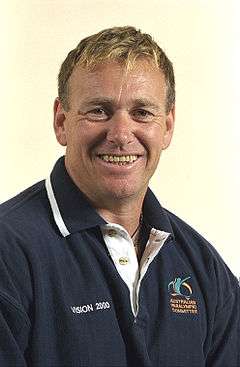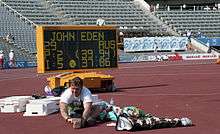John Eden (athlete)
John Desmond Eden (born 27 October 1955) is a leg-amputee athlete and Australian and New Zealand Paralympian.
 2000 Australian Paralympic Team portrait of Eden | |||||||||||||||||||||||||||||||||||||||||
| Personal information | |||||||||||||||||||||||||||||||||||||||||
|---|---|---|---|---|---|---|---|---|---|---|---|---|---|---|---|---|---|---|---|---|---|---|---|---|---|---|---|---|---|---|---|---|---|---|---|---|---|---|---|---|---|
| Full name | John Desmond Eden | ||||||||||||||||||||||||||||||||||||||||
| Nationality | |||||||||||||||||||||||||||||||||||||||||
| Born | 27 October 1955 Wellington, New Zealand | ||||||||||||||||||||||||||||||||||||||||
Medal record
| |||||||||||||||||||||||||||||||||||||||||
Personal
Eden was born in Wellington, New Zealand and given up for adoption by his young parents.[1] Eden attended Matamata High School and left home at the age of 15.[1] He completed Year 12 certificate through night school while working during the day.[1] At this time his main focus was to become an All Blacks rugby player.[1] In 1976, he lost his right leg below the knee in a motorcycle accident.[1] The day before his accident, Eden was advised of his selection in the Junior All Blacks.[1] He continued to play rugby at senior club reserves level but two years later his right knee was seriously damaged and he underwent an amputation above the knee.[1] He met another amputee, Brian Portland who encouraged him to become New Zealand's first amputee Paralympian.[1] This was the start of a 20-year career in competitive Paralympic athletics.[1]
In 1994, Eden's fiancé Mandy was killed in a car accident. Mandy had played a large part in reuniting him with his birth parents.[1] Eden's father was a New Zealand representative in boxing, softball and rugby league.[1]
Career

Eden won a silver medal in the Men's high jump C event at the 1980 Arnhem Games. He also competed in the Men's 100 m C, 400 m C and Men's Long Jump C athletics events, and the Men's 100 m Freestyle C-D – swimming event.[2] In 1982, he emigrated to Australia due to inadequate support to New Zealand Paralympic athletes. In 1984, he decided to turn his attention to the discus and stated I was not really tall enough (for the high jump) and lost a lot of natural spring after the second amputation"”.[1]
At the 1988 Seoul Paralympics, he competed for Australia and won a bronze medal in the Men's Discus A2A9 event.[2] At the 1990 World Championships and Games for the Disabled in Assen, Netherlands, he won a bronze medal in the men's discus 5F.[3]
In 1991, the Australian Institute of Sport (AIS) established an Athletics with a Disability Program and he became an inaugural scholarship holder and was coached by Chris Nunn.[4][5] In joining the AIS, Eden stated "Having this opportunity to train at the AIS has made all the difference and helped me improve immeasurably. And working with a coach like Chris increases my desire to continue with sport and, eventually to take up coaching myself".[6]
At the 1992 Barcelona Paralympics, he won a silver medal in the Men's Discus THS2 event and competed in the Men's Long Jump J1, Men's Shot Put THS2 and Men's Pentathlon PS3 events.[2]
He also competed in the 1994 IPC Athletics World Championships in Berlin, where he won a gold medal in discus and set a world record.[1]
Eden won a bronze medal in the Men's Discus F42 event at the 1996 Atlanta Paralympics.[2]
His Paralympic Games career as a competitor finished at the 2000 Sydney Paralympics where he competed in the Men's Discus F42 and Men's 100 m T42 events. At the end of his Paralympic career in 2000, Eden said "I like competing; it is a nice way to meet people and it makes me feel normal. The Paralympics are the pinnacle for athletes like me and this is a very nice way to live my life".[7]
Eden's athletic ability was highlighted at the AIS in 1995, where in a resistance test he recorded the highest score. The test included able bodied throwers including John Minns, multiple Australian shot put champion.[1]
Coaching
Eden's love of sport has continued through coaching at Frankston Athletics Club and the Victorian Institute of Sport. He has coached Paralympic bronze medallist Don Elgin[8] and Dale Stevenson, a bronze medalist at the 2010 Delhi Commonwealth Games.[9]
Eden is currently coaching Paralympic athletes Madeleine Hogan,[10] a world leading F46 javelin thrower, Charlotte Saville,[11] and Brydee Moore.[12] He was an athletics coach with the Australian team at the 2004 Athens Games[13] and 2008 Beijing Games.[14]
References
- Cherry, Tiffany (March–April 1995). "A survivor comes to the fore". Australian Runner and athlete. 14 (6): 48–49.
- "Athlete Search Results". International Paralympic Committee. Retrieved 3 February 2012.
- World Championships and Games for the Disabled – Athletics Results. Netherlands: Organising Committee. 1990.
- "Australian Sports Commission Annual Report 1991/92" (PDF). Archived from the original (PDF) on 31 March 2012. Retrieved 2 February 2012.
- "Australian Institute of Sport Honour Roll for the Paralympics". Archived from the original on 23 February 2012. Retrieved 2 February 2012.
- "They'll reign in Spain". Sports Chat (70): 7. September 1992.
- "One leg no hindrance for Paralympian". Australian Sports Commission Media Release, 11 October 2000. Archived from the original on 29 March 2011. Retrieved 2 February 2012.
- "Don Elgin". Athletics Australia Athlete Profiles. Archived from the original on 16 October 2009. Retrieved 5 February 2012.
- "Athlete diary: Stevenson ponders why he chose athletics". Athletics Australia News, 19 August 2010. Retrieved 5 February 2012.
- "Madeleine Hogan". Athletics Australia Athlete Profiles. Retrieved 5 February 2012.
- "Charlotte Saville". Australian Paralympic Committee – Athletes and Coaches. Archived from the original on 17 March 2012. Retrieved 5 February 2012.
- "Brydee Moore". Australian Paralympic Committee – Athletes and Coaches. Retrieved 5 February 2012.
- Media Guide – Athens 2004 (PDF). Sydney: Australian Paralympic Committee. 2004.
- Media Guide – Beijing 2008 (PDF). Sydney: Australian Paralympic Committee. 2008. Archived from the original (PDF) on 22 December 2015.
External links
- John Eden at Athletics Australia at Archive.today (archived 5 October 2013)
- John Eden at Paralympics New Zealand
- John Eden (Australia) at the International Paralympic Committee
- D. J. Eden (New Zealand) at the International Paralympic Committee